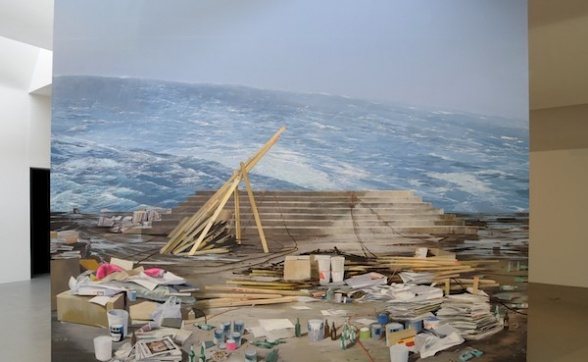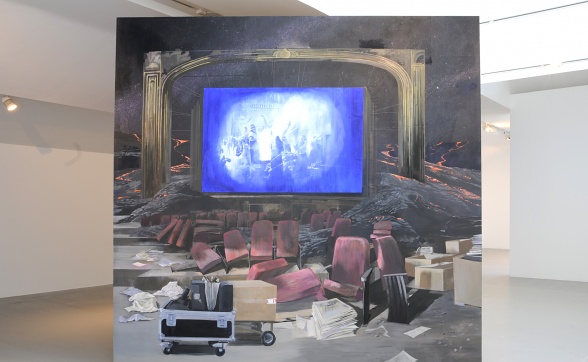Adam Cvijanovic

Adam Cvijanovic, Memory Palace of a Minor Despot (Partial Reconstruction), 2008. Photograph by Adatabase

Adam Cvijanovic, Memory Palace of a Minor Despot (Partial Reconstruction), 2008. Photography by Adatabase

Adam Cvijanovic, Memory Palace of a Minor Despot (Partial Reconstruction), 2008. Photography by Adatabase
Adam Cvijanovic, Memory Palace of a Minor Despot (Partial Reconstruction), 2008. Photograph by Adatabase
Appropriating the structural systems, perspective and spatial logic of Renaisance frescos, Adam Cvijanovic (b.1960, Cambridge) moves the medium of painting back to the realm of architectural and classical allegory. His paintings are on Tyvek, a material midway between paper and fabric, and are exhibited attached to architectural structures or directly to the building, creating a temporary site-specificity (for they can be removed and repurposed). Highly illusionistic scenes, typically on a grand and enveloping scale, shift the viewer in place and time.
Cvijanovic’s installation for MADE UP rested upon classical mnemonics, later developed by the Renaissance thinker Giulio Camillo Delminio whose L’Idea del Theatro (1550) described an encyclopaedic memory aid in the form of an amphitheatre with hundreds of images arranged over seven tiers. This approach maintained that places, real or schematic, can be used as an ordering framework to trigger memories of extended concepts too complex for the capabilities of normal recollection. A sequence of rooms, for example, may each be given an emblem to represent a passage of a text that, when viewed in the appropriate order, would facilitate the recollection of the complete construct. A similar system was employed by Giordano Bruno, and may have formed a part of Shakespeare’s original Globe theatre.
What is notable about the memory theatre, and what it shared with Cvijanovic’s work, is that it followed the idiosyncratic nature of memory itself and allowed each symbol and reference to mean something different to each user or viewer. Cvijanovic presented four paintings each mounted to the side of a cube, approximately four metres square. Each of the four scenes; a ramshackle studio space gradually moving into a vast ocean scene in the background, a concrete floor with a star-lit sky above, a mundane, dilapidated green couch placed against a barren Mediterranean landscape, and finally an epic waterfall, was loaded with Classical reference. The backgrounds slid into the mythical and even spiritual. Yet the ease of the journey from one place to the other took this a step further, promoting a game of free association in the subconscious that owed a debt to the strategies of the surrealists.
As well as being a tool to memorise concepts, the memory theatre existed to facilitate spontaneous creativity, something Cvijanovic’s paintings also achieved. The randomness of the disparate objects the artist presented not only alluded to the fragmented processes of narrative construction but allowed us to reconfigure them as we navigated its structure. As the images were arranged over four adjacent surfaces, it was impossible to see all sides of the puzzle simultaneously and nearly impossible to see an image in isolation. To view and move around the cube was to open up the possibilities of multiple readings as images and concepts collided and floated freely from one to another. To navigate the structure and release its numerous formulae was the equivalent of your hands turning the multiple faces of a Rubik’s cube.
Adam Cvijanovic at Liverpool Biennial 2008
Memory Palace of a Minor Despot (Partial Reconstruction), 2008
Flash and house paint on Tyvek
Commissioned by Liverpool Biennial 2008
Exhibited at Tate Liverpool
Liverpool Biennial
55 New Bird Street
Liverpool L1 0BW
- T +44 (0)151 709 7444
- info@biennial.com
Liverpool Biennial is funded by
Founding Supporter
James Moores